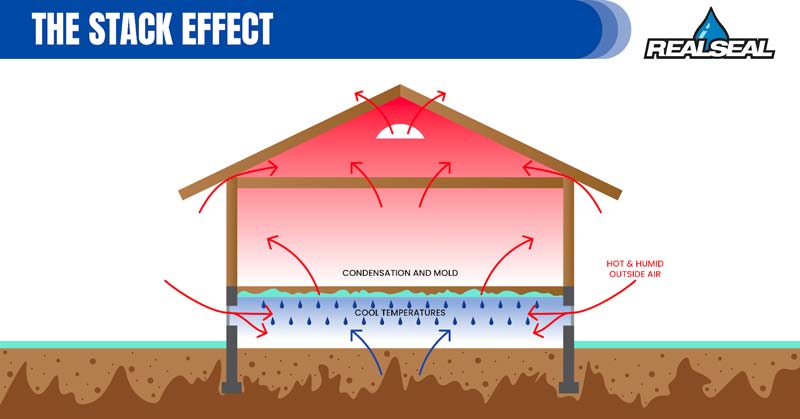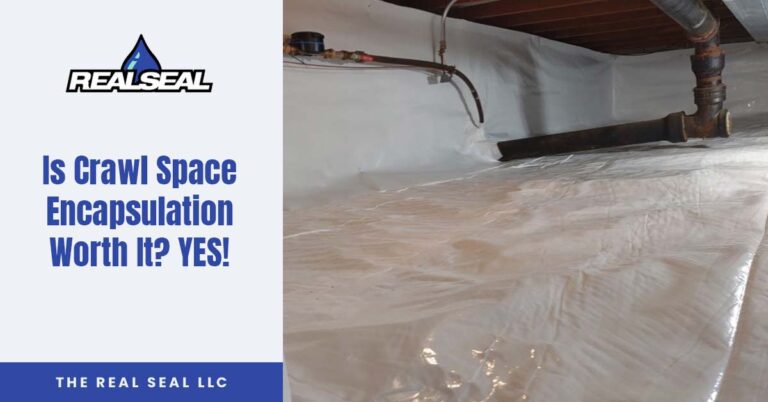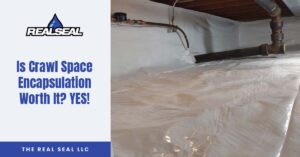Wondering if crawl space encapsulation is worth it? If so, don’t hit that back button because you’ve landed on the right page. In this article, we will go over what crawl space encapsulation is, how it’s done, whether it’s worth the expense, the downsides to encapsulation, and more.
What Is Crawl Space Encapsulation?
Crawl space encapsulation is the process of sealing off the crawl space beneath a home from the outside environment. Crawl spaces provide a haven for moisture, mold, and pests. Crawl space encapsulation involves sealing the crawl space with a vapor-retarding barrier to prevent moisture from entering the area.
Is Crawl Space Encapsulation Worth It?
You bet crawl space encapsulation is worth it and we’re going to explain why in this article. We’re also going to explain how you can go one step further and really ensure that your home’s crawl space remains clean, dry, and a safe place for storing things like tools and holiday decorations.
Why Moisture In A Crawl Space Is A Bad Thing
Moisture in a crawl space is bad because it can lead to severe structural problems. Moisture also creates the perfect breeding ground for mold and fungal growth. Mold thrives in damp and humid environments, so wet crawl spaces are particularly vulnerable to mold and mildew infestations. Because of the stack effect (see the infographic below), these organisms can compromise the air quality inside your home’s living area.
Another problem caused by moisture in crawl spaces is the growth of wood rot. This can happen when the humidity level in the crawl space remains too high for too long, causing the wooden structures in the crawl space to become moisture-saturated and decay over time. This type of damage can be significant and often requires costly repairs.
High moisture levels in the crawl space can also attract pests, including termites and other wood-boring insects. These pests can damage the home’s structural integrity, leading to costly repairs.
Finally, excessive moisture in crawl spaces can also potentially lead to higher energy bills because humid air costs more to heat and cool.
Proper crawl space moisture management is essential for maintaining a healthy and comfortable living space and safeguarding your home’s structural integrity.

How Moisture Enters A Crawl Space
Moisture has the potential to infiltrate crawl spaces in numerous ways, including the following:
- Through the crawl space’s dirt floor – One of the main ways moisture enters a crawl space is through the soil beneath the house. Groundwater can saturate the soil and permeate the foundation walls and floor, causing unwelcome dampness.
- Through tiny cracks in the foundation wall – Water can penetrate the foundation wall via cracks. If hydrostatic pressure has built up in the ground around the foundation due to poor drainage, this makes it even easier for moisture to infiltrate the crawl space through a foundation wall.
- Open vents – Hot, humid air flows into the crawl space via open vents and condenses on cooler surfaces. This will increase the amount of moisture in the crawl space.
- Plumbing leaks – Leaky plumbing is another source of crawl space moisture.
The presence of moisture can lead to a slew of issues, such as mold growth, wood rot, and insect infestations, among other things.
Benefits Of Crawl Space Encapsulation
Crawl space encapsulation has a host of benefits for homeowners, including the following:
- It can improve air quality inside your home’s living area – This is because some of the air in the crawl space flows into your home’s living area due to the stack effect. (See the infographic below). If your crawl space is full of mold, the air flowing into your living area will be full of mold spores. So, by reducing the amount of moisture and humidity in the crawl space – which can lead to mold growth – the air entering your home from the crawl space will be drier and cleaner.
- It can prevent structural damage to the home – Encapsulation protects your home from structural damage by preventing moisture from seeping into the foundation and causing wood rot.
- Encapsulation can also improve energy efficiency – While we can’t guarantee it, some homeowners have reported lower energy costs after encapsulation. This is probably because encapsulation lowers humidity in the crawl space, so the air flowing into your home’s living area is drier. Dry air is less expensive to heat and cool.
The Crawl Space Encapsulation Process
The process of crawl space encapsulation typically involves a thorough cleaning of the area, followed by sealing off any vents and installing a vapor-retarding barrier on the crawl space floor and walls. Most homeowners also choose to add a dehumidifier to the crawl space to ensure the humidity level stays low.
Crawl space encapsulation is a cost-effective and relatively simple way to improve a home’s health, safety, and comfort. Homeowners can enjoy a cleaner, drier, and more energy-efficient living environment by preventing moisture, mold, and pests from entering the crawl space.
Add a dehumidifier for added protection
Most homeowners also add a dehumidifier to the encapsulated crawl space to ensure the humidity level remains low. There are even ways to monitor the humidity level in the crawl space from inside your home.
Kick It Up A Notch: Drain Tile System Plus Crawl Space Encapsulation
While crawl space encapsulation is totally worth it, you can really kick it up a notch by installing a drain tile system as well.
What is a drain tile system?
A drain tile system is a foundation waterproofing method that prevents excess moisture from building up in the ground around the foundation. When it comes to foundation waterproofing, a drain tile system is the gold standard.
There are two types of drain tile systems, exterior and interior.
An exterior drain tile system consists of a perforated drainage pipe laid around the outside perimeter of the foundation at the footing level. The soil around the foundation is excavated down to the footing, and then a shallow trench is dug and lined with gravel. A perforated drainage pipe is placed into the trench and covered with more gravel. Finally, the excavated soil is replaced. Excess moisture in the ground around the foundation will now enter the drainage pipe and make its way toward a sump pit. When the sump pit fills with water, a sump pump will turn on and eject the water away from the foundation.
An interior drain tile system goes around the inside perimeter of the crawl space. It similarly collects excess water and directs it safely away from the foundation.
A drain tile system – exterior or interior – ensures that excess groundwater is diverted from the foundation and crawl space. Encapsulation provides additional protection against moisture by sealing off the crawl space. Together, they will ensure your home’s crawl space stays dry and free of moisture, mold, and other related problems.
Are There Any Downsides To Crawl Space Encapsulation?
The main downside to crawl space encapsulation is the cost. Crawl space encapsulation isn’t exactly a budget-friendly solution. However, the upside is that the investment provides long-term benefits that outweigh the cost.
The other downside to crawl space encapsulation is that it isn’t a DIY project. Encapsulating a crawl space is a job for the pros. While some homeowners may want to give it a shot as a DIY project, we don’t recommend it. Crawling around under your house can be dangerous and improper installation could ultimately mean higher repair costs if a professional needs to come in and do the job correctly.
Other Ways To Help Keep Your Crawl Space Dry
In addition to encapsulating your crawl space and installing a drain tile system, there are some other things you can do to help keep your crawl space dry. These include the following:
- If necessary, regrade the yard around the foundation – This is done to ensure water flows away from your foundation rather than towards it. If the ground around your home slopes toward your foundation, groundwater will naturally be directed toward your crawl space, increasing the chances of water damage.
- Another helpful solution is installing downspout extensions – Downspouts are designed to channel rainwater away from your roof and foundation. However, without proper downspout extensions, runoff will be deposited next to your foundation, where it can then seep into your crawl space. Installing downspout extensions that direct water at least 15 feet away from your foundation is an excellent way to minimize the risk of water damage in your crawl space.
- Maintaining clean gutters is also crucial if you want a dry crawl space – Gutters are essential for directing rainwater away from your home, but if they are clogged with leaves, twigs, and other debris, they won’t function correctly. This can lead to water spilling over the side of your house and soaking into the ground around the crawl space.
- Avoid planting water-hungry vegetation next to your foundation – Flowers, trees, and shrubs that require a lot of water can cause the soil around your crawl space to become saturated, increasing the risk of water entering your crawl space. Instead, opt for plants that require less water or plant them away from your foundation.
If you’re thinking about encapsulating your Chicagoland home’s crawl space, contact The Real Seal today to schedule an evaluation and receive an estimate.






